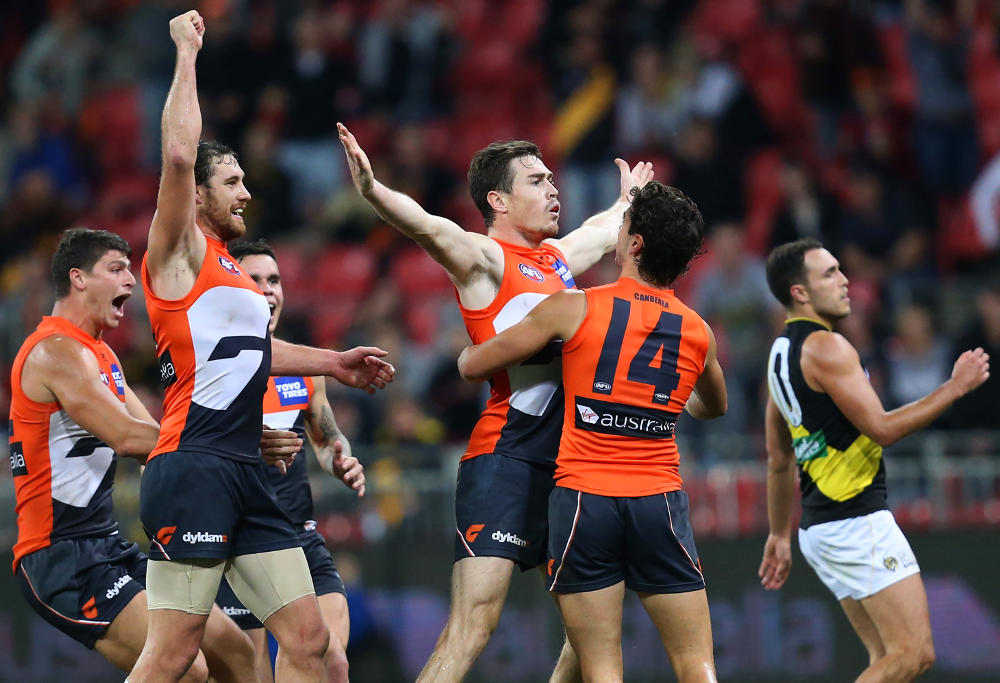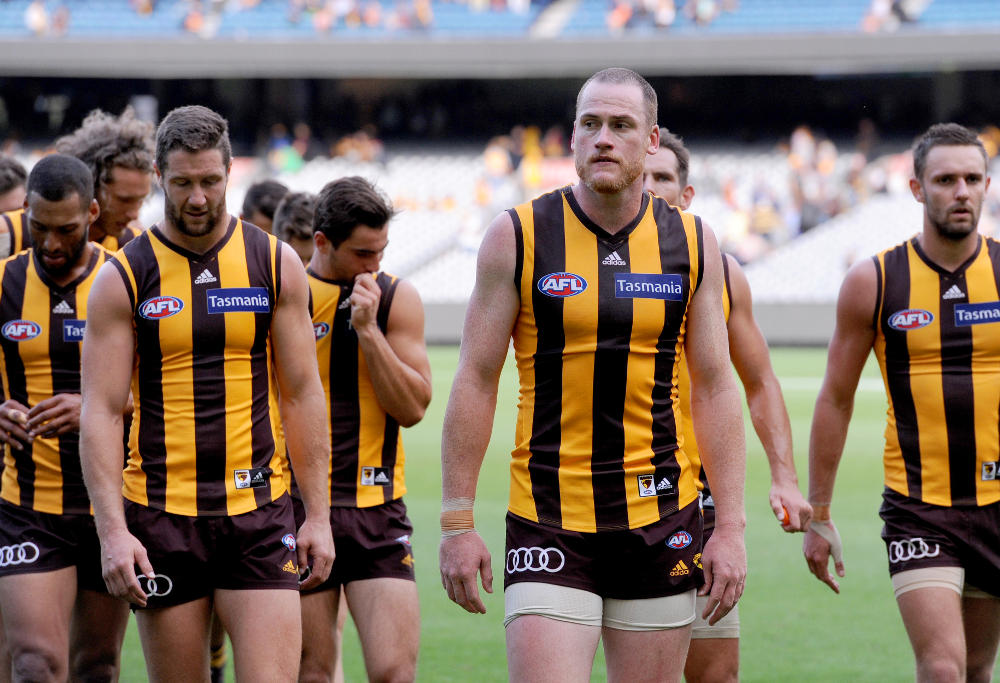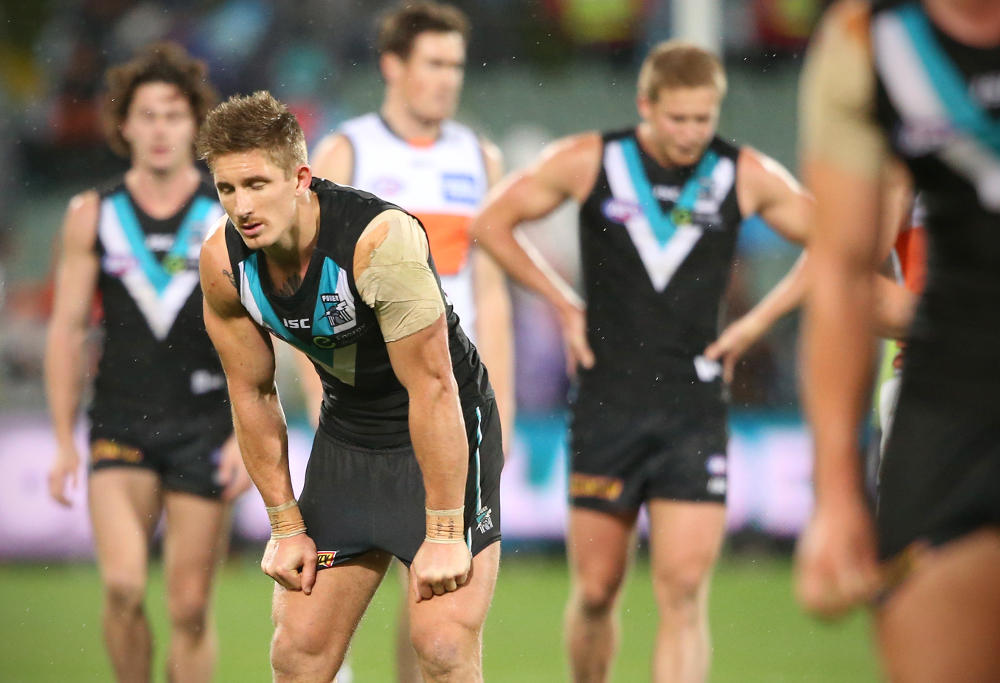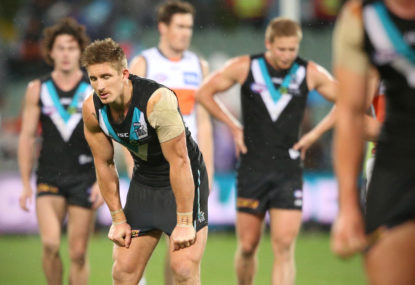After a chaotic Round 12, the AFL ladder is almost completely up in the air. The gap between fifth and 17th is just two wins, and most of the competition can harbour realistic finals ambitions with half of the season still to come. I told you so: the 2017 AFL season is lit.
It’s worth remembering that this time last year, the top eight had been in place for seven bloody rounds. Seven rounds! That was early by historic standards; in a typical post-2000 AFL season, we can expect six of the top eight to be in place. In Round 6 this year, this is what the ladder looked like.
| Team |
Wins |
Percentage |
| Adelaide |
6 |
160.9% |
| GWS |
5 |
133.3% |
| Geelong |
5 |
131.9% |
| Richmond |
5 |
112.0% |
| Port Adelaide |
4 |
152.2% |
| West Coast |
4 |
113.1% |
| Western Bulldogs |
4 |
110.5% |
| Melbourne |
3 |
108.4% |
| StKilda |
3 |
106.0% |
| Essendon |
3 |
91.7% |
| Fremantle |
3 |
75.2% |
| Collingwood |
2 |
93.3% |
| Gold Coast |
2 |
89.0% |
| Carlton |
2 |
74.8% |
| North Melbourne |
1 |
86.7% |
| Brisbane Lions |
1 |
68.4% |
| Hawthorn |
1 |
65.2% |
| Sydney |
0 |
76.6% |
Huh. The same eight teams. But unlike last season, there isn’t a wall forming between eighth and ninth place. Indeed, look at the state of this thing.
| Team |
Wins |
Percentage |
| Adelaide |
9 |
141.7% |
| GWS |
9 |
116.4% |
| Geelong |
8 |
117.3% |
| Richmond |
7 |
111.6% |
| Port Adelaide |
6 |
131.6% |
| Melbourne |
6 |
110.9% |
| Western Bulldogs |
6 |
102.4% |
| Essendon |
6 |
102.3% |
| West Coast |
6 |
101.4% |
| Fremantle |
6 |
78.5% |
| Collingwood |
5 |
101.7% |
| StKilda |
5 |
92.9% |
| Gold Coast |
5 |
88.2% |
| Sydney |
4 |
105.0% |
| North Melbourne |
4 |
93.8% |
| Carlton |
4 |
80.5% |
| Hawthorn |
4 |
78.1% |
| Brisbane Lions |
2 |
70.2% |
The fourth-placed Richmond sit on 7-4, six teams from fifth to tenth are on six wins (some of whom have played 11 games, some 12), and a further three teams are on five wins (ditto above). Furthermore, the Sydney Swans (probably the best 4-7 team ever) lurk two games out of eighth place themselves sitting in 14th on the ladder.
That’s nine teams all within a game of fifth, and an additional team who was pegged as a premiership fancy sitting just one game behind them.
What the hell is happening?
My answer, as it was in the preseason, is the last vestiges of the expansion era distortion have wound their way into and out of the league. The more nuanced answer was provided by Carlton coach Brendon Bolton in his post-match press conference after his team’s win against the ladder-leading GWS Giants.
When asked about where that win stacked up in the scheme of his time as Carlton’s chief football person, Bolton responded with some sage words. “We should understand that the competition is a lot more even than people realise, and you can look too deeply into ladder positions all the time.”
This column has been encouraging this line of thinking almost since its inception in early 2015. The ladder lies to you. Its very design is conceited, particularly at this time of year when byes wreak havoc on the currency of the code: wins.
Looking through the ladder is a challenge, particularly when your team is in the top eight. The temptation to use it as a method of assessment is great.
Fortunately, we’ve got a few up our sleeves. We ran through this year’s halfway point Numbers Game a fortnight ago. The biggest part of that is Pythagorean wins, which take a team’s scores for and against and dish out wins assuming football wasn’t divided up into 120-minute parcels of action. Those numbers are updated post-Round 12, while there’s a couple of extra columns added in for good measure.
The second column is a team’s percentage, adjusted for their strength of schedule. This takes a team’s points for and against, and adjusts for who they’ve played. A higher number is better, as you’d expect. Between the two, we get a decent view of how well a team has performed in their 11 or 12 games played to date.
| Team |
Pythagorean Wins |
Schedule-adjusted Percentage |
| Adelaide |
10.0 |
143.7% |
| Port Adelaide |
8.6 |
127.7% |
| Greater Western Sydney |
8.0 |
125.4% |
| Geelong |
7.4 |
122.6% |
| Richmond |
6.8 |
113.4% |
| Melbourne |
6.8 |
113.0% |
| Essendon |
6.4 |
108.8% |
| Western Bulldogs |
5.8 |
105.0% |
| Sydney |
6.1 |
104.8% |
| WCE |
5.7 |
104.9% |
| Collingwood |
6.2 |
102.0% |
| North Melbourne |
4.7 |
102.4% |
| StKilda |
4.6 |
98.4% |
| Gold Coast |
4.0 |
90.9% |
| Carlton |
3.1 |
87.8% |
| Fremantle |
3.1 |
84.2% |
| Hawthorn |
2.9 |
81.4% |
| Brisbane Lions |
1.8 |
68.6% |
Funnily enough, the best eight teams on these metrics are, for the most part, the top eight. The exception is the West Coast Eagles, who find themselves in ninth place on percentage but with a game in hand against Essendon in seventh. Still, the gap between the best and worst is small in the scheme of things.
The trick in all this, of course, is that the ladder is ultimately the measuring stick. Eight teams make it into the finals series, and they aren’t the eight best teams on Pythagorean wins or strength of schedule adjusted percentage. That would be a far less dramatic and enjoyable way for it all to play out.
So, we’re left with a very similar dilemma to the one we were posed with on 23 March at 7:19pm Eastern Standard Time: how do we get the bigger number to fit into the smaller number? It will prove a more challenging task than in recent years, because the big number is the largest it’s been in at least five years, and perhaps longer.
In this environment, no team currently snug in the eight is really safe from falling out due to a bad run of form over a three or four-week stretch. But for the sake of our sanity, let’s assume Adelaide, GWS and Geelong are locked into the eight by virtue of their two or three extra wins over eighth spot.
Most bookmakers have paid out on the Crows and Giants top-eight market and are probably pretty close to doing the same for the Cats.

(AAP Image/David Moir)
Eight-point games, ahoy!
One way to frame the last ten games of the season is to look at how many potential eight-point games a team has left to play. That is, how many games will each of the teams ranked four through to 13th (we’ll keep Sydney off to one side for now) play against opponents also in the mid-table mire.
These are effectively what the AFL media like to call eight-point games. They’re important because a win in one for your team means they earn four points, but also get to keep them off the balance sheet of a rival that’s in a similar position. Talk of eight-point games normally begins to heat up around Round 19 or 20, as the picture becomes clearer and the binary nature of wins and losses more apparent.
Teams that play a lot of eight-point games control their destiny, and the destiny of those around them. Win the lion’s share from here and finals football is within reach. As you’ll see below, plenty of teams have more than half of their remaining games scheduled against teams currently in the mire. Their 2017 seasons are on the line from this weekend.
This year, the eight-point game season starts this weekend. Every break a team is able to open up against their fellow mid-table mire adversaries is an air pocket in the cave of rising water trying to drown them and knock them out of contention.
With the pre-finals bye in place for at least this year, every team will place greater stock than ever in making it into the final eight. The Dogs did something spectacular last season, and until proved otherwise we, and the clubs, must assume the pre-finals bye had something to do with it.
The 2017 table of mid-table madness
Here it is.
|
R13 |
R14 |
R15 |
R16 |
R17 |
R18 |
R19 |
R20 |
R21 |
R22 |
R23 |
Total |
| Collingwood |
B |
• |
|
• |
• |
• |
|
|
• |
|
• |
6 |
| Essendon |
B |
|
|
• |
• |
|
• |
|
|
• |
• |
5 |
| Fremantle |
B |
|
• |
|
• |
|
|
• |
|
• |
• |
5 |
| Gold Coast |
|
• |
|
|
• |
• |
• |
• |
|
• |
• |
7 |
| Melbourne |
• |
• |
|
|
|
• |
|
|
• |
|
• |
5 |
| Port Adelaide |
|
• |
• |
• |
|
• |
• |
|
• |
• |
• |
8 |
| Richmond |
|
|
• |
• |
|
|
• |
|
|
• |
• |
5 |
| St Kilda |
|
• |
• |
• |
• |
|
• |
• |
• |
|
• |
8 |
| West Coast |
|
• |
• |
• |
• |
• |
|
• |
|
|
|
6 |
| Western Bulldogs |
• |
|
• |
|
|
• |
• |
|
|
• |
|
5 |
There are two interesting developments that aren’t in this table.
First, North Melbourne plays nine of its last 11 games against the teams currently on five or six wins, all but one in a seven-week stretch starting this weekend. They themselves are on four wins.
If the ‘Roos are indeed an unlucky team that should be closer to a 0.500 record, they have an incredible opportunity to rise up into finals contention by getting on a bit of a run over the next month or so. I wouldn’t count on it if I were a North fan – the ‘Roos have only underperformed their Pythagorean win total by 0.7 wins, and have shown zero aptitude for full 120-minute games of football in 2017 – but it is something to keep an eye on.
At the opposite end of the spectrum, Hawthorn plays just four of its final ten games against mid-table sides. They are also on four wins, but given this, they face a much tougher time self-resuming their corpse of a season.
The tank should have been on a few weeks ago; given this information, Hawthorn will almost certainly start to play the kids, send sore players off for season-ending surgery, and begin a farewell tour for any of the veterans it may wish to see bow out in 2017.
Fortunately for Alastair Clarkson and co, they will be able to do this with a relatively strong cover shadow of darkness enveloping the team – Hawthorn’s last relevant act in the 2017 home-and-away season was likely boosting the Suns’ chances of making the finals in the weekend just gone.

(AAP Image/Joe Castro)
As for the teams that find themselves in the mid-table, the takeaways are numerous.
St Kilda are in full control of their destiny. Of their 11 remaining games, the Saints play eight of their mid-table fellows. After a date with North Melbourne this Friday night, St Kilda face Gold Coast, Fremantle, Richmond and Essendon in consecutive weeks.
Now sitting in 12th with a percentage of 92.9 per cent (only ahead of the Dockers and Suns in the mid-table), this looms as a season-defining stretch. Splitting the ledger is not enough if the Saints wish to play in September a year or two ahead of schedule as many predicted they would in the preseason.
While the Crows were able to put up a large score on the Saints last Friday, that was something of a misnomer in St Kilda’s season. The Saints have the league’s seventh-worst defence using points against as the marker, but in a metric I’m working on that adjusts for the offensive and defensive prowess of the opposition, the Saints have been no worse than average.
Their scoring is their problem, which I put down to an unsettled forward line. After scoring 100 points or more in seven of their 14 Etihad Stadium outings last season, and three times at other stadia, the Saints have put up triple digits just three times in 11 games in 2017.
St Kilda try to play an up-tempo but efficient game, having their cake and eating it too in the pace and space era. It is yielding low volumes (46.5 inside 50s per game, ranked 12th) of relatively poor quality supply, particularly compared to teams that move the ball more directly and through the middle of the ground.
It’s fine, because St Kilda’s list remains raw in the scheme of things, and still in need of some time to marinade. If you take Nick Riewoldt, Leigh Montagna, Sean Dempster (who’s already retired) and Sam Gilbert off the list, St Kilda have the second youngest and the least experienced list in the competition.
Keep that in mind if the Saints drop two or three of their next four or five games and the vultures begin circling.
Port Adelaide similarly play eight of their fellow travellers in their run home. The Power are increasingly difficult to get a solid read on; their best is insatiable, suffocating, punishing. Their worst, like they showed over the weekend, reminds me of their defensive no-shows from 2015 and 2016.
It was Port Adelaide’s first major loss in the year, and in the spirit of the football, media questions are now being asked.
Port play a high risk, high reward style, relying on an aggressive press to win repeat forward 50 entries and grind their way to high scores. It helps buttress their defence, which is somewhat light on personnel outside of the reliable Jack Hombsch. It works well when it works – the Power are the best defensive team in the competition on team-wide metrics – but when it doesn’t, teams can put up large scores.

(AAP Image/Ben MacMahon)
The Power are 2-3 in their past five games, losing to West Coast, Geelong and Essendon – all of whom were in the top eight at the time. Port have beaten up on a few teams at the bottom of the ladder and won against every team they’ve played that sat below them on the table heading into the game.
They look more like a fifth to eighth side than a top four side with the benefit of hindsight, but with the schedule they’ve got coming up, a top-four finish is still in play.
A team who should on all reasonable preseason estimates be in the top-four discussion is West Coast, who are in ninth with a percentage of just over 100 at the halfway mark of the season.
West Coast’s macro settings are all tuned to win now: they’re old, experienced, seasoned, stable and mature. They’ve made finals for two years in a row and made a grand final in 2015. According to ESPN’s Matt Cowgill, West Coast have handed just 20 per cent of their total games to players aged 23 or younger in 2017 – less than half the competition average (44 per cent).
Yet it’s not working, or at least it’s not working consistently. The Eagles have been caught out by the pace and space revolution of the AFL in 2016 and 2017, and have a team filled with Hawthorn-style kick-mark preference plodders.
That’s harsh, but not too far from the truth. The Eagles are slow and have no path to getting fast without some significant changes to their list. Given the list profile, that’s not going to be a simple flick of the wrist.
The Eagles’ season is at a crossroads. A difficult assignment against the rock ‘em, sock ‘em Geelong looms tomorrow, albeit in the familiar surrounds of Subiaco Oval where West Coast have won four of their five outings with a percentage of 122 per cent.
Still, the market is selling, and the fan-base is increasingly nervous. Should the Eagles fall a game behind eighth spot, and seeds greater than seven begin to look like they’ll require some mathematical chicanery to materialise, decisions will need to be made.
Does Sam Mitchell stay on, or commence his assistant coach career? Does Nic Naitanui come back at 90 per cent fitness following his ACL tear, or wait until next season and return at his peak? Does the club start to lift the role of Dom Sheed, Liam Duggan, Jackson Nelson and other chosen youngsters? Are Sharrod Wellingham, Jack Redden and Lewis Jetta part of the solution, or the problem? Will Adam Simpson stop playing Josh Hill and Jamie Cripps in the same god damn forward line (sorry)?
Let’s suck it and see, and check back in a couple of weeks. West Coast has a season-defining stretch coming up: Geelong, followed by Melbourne, the Western Bulldogs, Port Adelaide and Fremantle. At the end of this, we will know for certain whether they are playing finals in 2017.
Indeed, a more interesting question might be looking to 2018 and beyond. West Coast’s current list is not too far from a more significant decision gate, if we’re being objective.
The Eagles are just one of many intriguing storylines just bursting to unfurl over the next 11 rounds of football. The Tigers. The Dogs. The Dees. The Hawks. The Blues. The Suns. The Giants. The Bombers. It’s like we’re living in a football planetarium, with shiny things flashing in and out of focus, drawing our attention this way and that.
And you thought the first three months of the season were hectic.
































































































